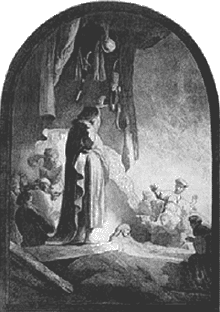Copper in Art Through the Ages
 The Raising of Lazarus by Rembrandt - Etching on a Copper Plate.
The Raising of Lazarus by Rembrandt - Etching on a Copper Plate.High-resolution version of this photo.
The usefulness of copper in metalwork is known to all, but few people realize how much it has contributed to art and painting throughout history. Copper-based pigments were an important ingredient in ancient paints, and the metal itself was frequently employed as a "canvas" on which Renaissance artists painted. Copper also served as an engraving plate for etchings and prints by master artists such as Rembrandt.
As an ingredient in paint, natural copper ores such as azurite (blue) and malachite (green), add a depth and dimensionality to paintings that cannot be duplicated by man-made substitutes. As for copper's use as a canvas, there was virtually nothing else available to artists in pre-technological times that approached its smoothness and durability.
Copper Pigments in History
From artifacts dating back to the Egyptian Fourth Dynasty in 3000 BC, we have proof of the existence of a copperbased paint called Egyptian Blue, a permanent mixture of malachite with silicate and limestone. The deep cerulean hue was used on parchments, sarcophagi, statues, walls, buildings and objects. "The Egyptians did incredible decorative work," says George O'Hanlon, an owner of Natural Pigments, an artists' supply outlet in Willits, California, and a recognized authority on natural mineral and historical pigments.
The formula for Egyptian Blue was lost after the Roman period until it was recreated in the 19th Century. Until then, artists who attempted to produce the color were unable to properly burn malachite at high-enough temperatures over the time necessary to extract the copper essence.
Excellent examples of Roman use of copper- based paints are found at Pompeii, where volcanic ash preserved artwork that was not destroyed by the eruption of Mt. Vesuvius. Both the Romans and ancient Greeks also created a pigment called verdigris, a bluish green color, by immersing copper plates in vats of fermenting grape leaves. Corrosion produced a blue crust that was washed and dissolved in vinegar to produce a deep green.
Today, Natural Pigments is one of only two companies in the United States that offers Egyptian Blue pigment. "It's expensive - at nearly $20 for 10 grams," (about two teaspoons) says O'Hanlon.
"Azurite was the predominant blue from the Middle Ages through the Renaissance," he adds, noting that verdigris and malachite were also widely used during that period. "The bright greens in Michelangelo's Sistine Chapel are tints of malachite."
The use of copper-based paints fell out of favor in the 17th and 18th centuries as artists turned to new synthetic substitutes and brighter chromium-based colors.
Modern Day Masters
 The use of chlorinated copper phthalocyanine (phthalo green) is visible in the painting, "Melancholy." The oil-on-panel work was painted in 1987.
The use of chlorinated copper phthalocyanine (phthalo green) is visible in the painting, "Melancholy." The oil-on-panel work was painted in 1987. High-resolution version of this photo.
"Artists are currently reviving old materials, rediscovering the Old Masters and their techniques, which were quite special," says O'Hanlon. One of those artists, Virgil Elliott of Penngrove, California, strives for the rich degree of realism found in works by the great painters. He uses copper-based paints to achieve dark transparent colors that create strong contrasts in the way light plays on the canvas. "The degree of realism depends on the range of contrast," says Elliott, who is included in the Gallery of Living Masters, of the Art Renewal Center, and is author of "Traditional Oil Painting" to be published by Watson Guptil in 2007.
"I use two different copper phthalocyanine blues, one of which inclines toward green and the other is a true dark blue. By mixing the blue with transparent iron oxide red, I get a range of deep transparent browns similar to those used by the Old Masters," says Elliott.
Copper as Canvas
An exhibition at the Phoenix Art Museum in 1999 examined the use of the metal as a medium in Copper as Canvas: Two Centuries of Masterpiece Painting on Copper, 1575-1775. In the catalog of the exhibit, curator Michael Komanecky explains that, "Beginning in the early 16th century, European artists painted on small sheets of copper as part of a broader experimentation with painting on smooth surfaces." Those artists include some of the most famous painters of all time: Leonardo da Vinci, Jan Brueghel, El Greco and Rembrandt.
"The explosive growth of the practice was due to the discovery of the dazzling visual effects that could be achieved on this new support (copper), whether portraiture, landscape or religious subjects," Komanecky states.
According to Edgar Peters Bowron, curator of European Art at the Museum of Fine Arts in Houston, "The main reason artists chose copper was that it provided a smooth surface. There is no "tooth" to the surface, so you can use a very liquid brush that gives marvelous effects."
Barbara Berrie, senior conservation scientist at the National Gallery of Art in Washington, D.C., says the smooth copper surfaces were sometimes treated with intermediaries such as garlic or white lead paint to help oil paint adhere. Some coatings may have been highly reflective or "silvered," creating jewel-like effects, adds Bowron.
Berrie and National Gallery Chief Conservationist Ross Merrill point out that some of the artists' copper surfaces had a previous life as an etching plate. Merrill says more than half of the paintings he has seen on copper have been tested by X-rays that reveal etching on the plate. In fact, the back of the copper plate on which Rembrandt etched Abraham Entertaining the Angels had been used by another artist to paint a landscape.
In Copper as Canvas, Bowron states, "As artists accurately suspected, paintings on copper that are well cared for are extremely durable and generally survive in excellent condition. Owing to the protection given the paint film by the solidity and durability of the support and the absence of structural treatments or restorations, they often appear as brilliant and fresh as the day they were created."
Contemporary Copper Art
Contemporary artist David Novros is a good example of a modern-day artist who prefers the medium of copper sheets. He has a series of seven paintings on copper panels as large as 9x6 feet. His work has been shown at the Metropolitan Museum of Art and Museum of Modern Art in New York. "Copper is one of the most malleable metals; pigment bonds well to it, and I like its reflective nature," Novros explains. "Copper has a historical connection and was considered valuable, like gold and silver."
When Novros lived in the mining area of New Mexico in the 1980s, he became interested in copper. He bought copper pans, used to mine for gold, from a general store and soldered them onto thin copper sheets. Then he detonated line charge explosives atop them in a pre-planned pattern. The charge made indentations in the copper that gave it a "padded look," Novros says.
Novros subsequently painted directly on the panels with oil paints and synthetic resins. "The process of oxidation will change the painting in a way I am anticipating in my image-making," he notes. Even modern-day artists working with copper honor its significance in history and look forward to its contribution as a natural metal in the future of art. Cu
Resources:
Also in this Issue:
- Using Copper for What Ales You
- Copper in Art Through the Ages
- A Library Enhanced by Copper
- Architecture Defined By Copper
- Copper Reveals Age of Books, Art
